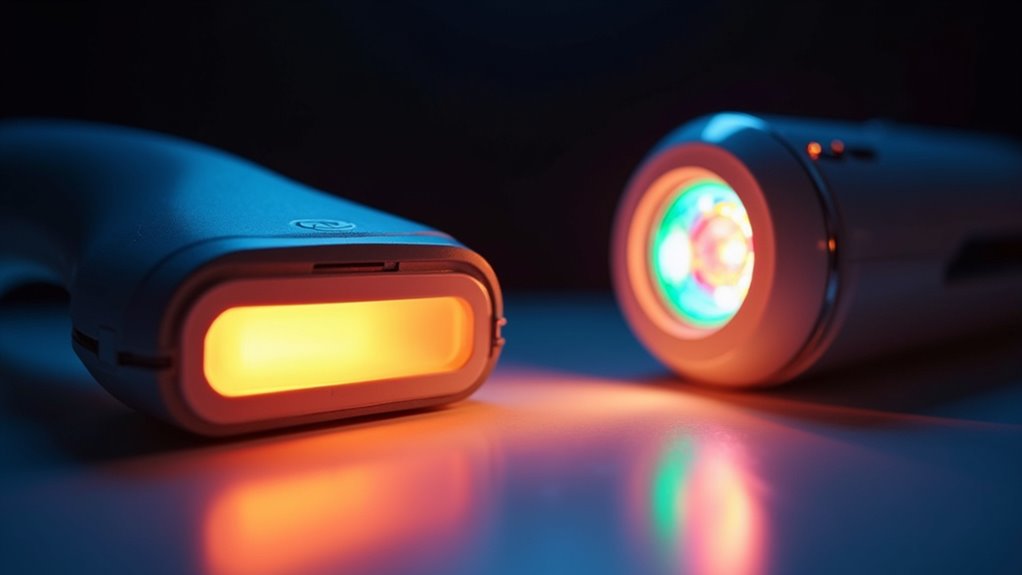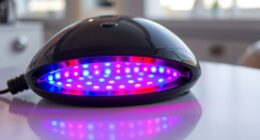IPL (Intense Pulsed Light) uses targeted, specific wavelengths designed for precise skin concerns like pigmentation and redness, while broadband light emits a wider spectrum to treat multiple issues simultaneously. IPL is often more suited for surface concerns and collagen stimulation, whereas broadband light can address deeper skin problems, including pigmentation and vascular issues. Understanding these differences helps you choose the best option, and exploring further reveals how each treatment can be tailored to your skin goals.
Key Takeaways
- IPL uses targeted, narrower wavelengths for specific skin issues, while broadband light emits a wider spectrum for multiple concerns.
- IPL is primarily used for hair removal and pigmentation, whereas broadband light addresses skin tone, redness, and overall skin rejuvenation.
- Longer wavelengths in broadband light penetrate deeper, similar to IPL, but broadband light covers a broader range of wavelengths.
- Both treatments require multiple sessions, but IPL offers more precise targeting, enhancing safety for specific skin conditions.
- Safety and effectiveness depend on device settings and skin type, with professional screening minimizing risks for both therapies.
Understanding IPL and Broadband Light: Basic Concepts

To understand the difference between IPL and broadband light, it’s essential to know what each technology does. IPL, or intense pulsed light, uses broad-spectrum light to target specific skin issues. It’s commonly used for laser hair removal and photo rejuvenation, helping reduce hair growth and improve skin tone. Broadband light emits multiple wavelengths, covering a wider range of skin concerns, including pigmentation, redness, and fine lines. While both treatments rely on light energy, IPL is more versatile for cosmetic procedures like photo rejuvenation, enhancing skin health and appearance. Laser hair removal, often associated with IPL, offers precise hair reduction, whereas broadband light can address multiple skin imperfections simultaneously. Understanding these basic concepts helps you decide which technology suits your needs best. Additionally, knowing how light-based treatments interact with skin can help set realistic expectations for outcomes.
The Technology Behind IPL and Broadband Light Treatments

Understanding how IPL and broadband light treatments work starts with their light wavelengths and spectrum, which determine their effectiveness. You’ll also want to know about the delivery mechanisms and devices used to target specific skin issues. Additionally, the expiration of vape juice can influence the safety and efficacy of light-based treatments, as expired products may contain degraded components. Finally, the treatment depth is essential for achieving desired results without affecting surrounding tissues.
Light Wavelengths and Spectrum
Light wavelengths and spectrum are fundamental to how IPL and broadband light treatments work, as they determine which skin issues can be targeted effectively. The specific wavelengths absorbed by skin structures influence their ability to promote skin rejuvenation and pigment removal. Longer wavelengths penetrate deeper, making them ideal for stimulating collagen and reducing fine lines. Shorter wavelengths focus on surface-level issues like pigment and redness. Understanding these differences helps you choose the right treatment. Key points include:
- Broader spectrum coverage allows targeting multiple skin concerns simultaneously.
- Specific wavelengths can be customized for precise pigment removal or skin rejuvenation.
- The spectrum’s range influences treatment depth, affecting safety and effectiveness.
- The choice of spectrum also impacts the overall treatment safety and patient comfort.
Delivery Mechanisms and Devices
The delivery mechanisms of IPL and broadband light treatments are powered by specialized devices that emit controlled pulses of light to target skin concerns. These devices vary in design, affecting their compatibility with different skin types and treatment areas. IPL devices typically use a broad spectrum of light filtered through specific handpieces, while broadband devices emit a wider range of wavelengths directly. The delivery mechanisms determine how precisely the light is delivered, influencing treatment efficacy and safety. Device compatibility is vital—you’ll want equipment suited to your skin type and treatment goals. Both IPL and broadband systems rely on advanced handpieces and filters that optimize light delivery. Understanding these mechanisms helps ensure you choose the right device for effective, safe, and comfortable treatments. Additionally, advancements in device technology have improved the precision and safety of these treatments, making them more accessible and effective for a variety of skin concerns.
Targeted Treatment Depth
Both IPL and broadband light devices utilize specific technologies to target different layers of the skin, which directly impacts how effective each treatment is for various concerns. The targeted treatment depth determines how deeply the energy penetrates, influencing results in cosmetic applications like hair removal, pigmentation, and vascular issues. Technological innovations have enhanced control over this depth, allowing for more precise treatments. Additionally, understanding how visual and auditory elements contribute to the effectiveness of these treatments can help optimize outcomes.
- Shallow depths suit surface issues like pigmentation, minimizing risk.
- Deeper penetration effectively targets hair follicles and vascular lesions.
- Adjustable settings enable customization based on skin type and concern.
Understanding these differences helps you choose the right treatment for your needs and ensures ideal, safe outcomes.
Differences in Light Wavelengths and Their Effects
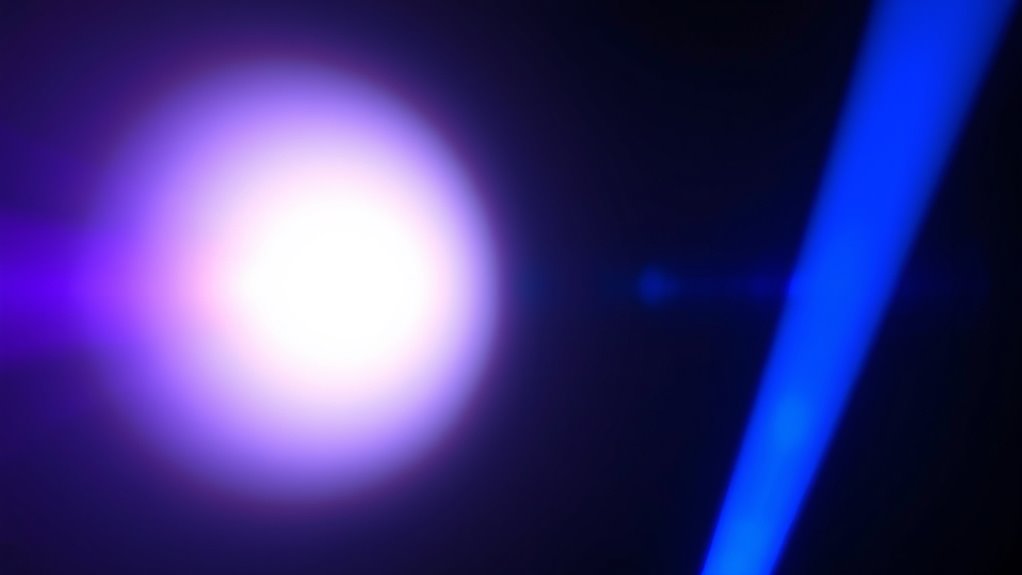
You’ll notice that IPL and broadband light emit different wavelengths, affecting how deeply they penetrate your skin. These variations influence the specific skin concerns each treatment targets and their overall effectiveness. Understanding these differences helps you choose the right option for your skincare goals. Additionally, the light source used in each therapy plays a crucial role in determining their safety and suitability for different skin types.
Wavelength Range Differences
Wavelengths differ markedly between IPL and broadband light, directly impacting their effectiveness and safety. The wavelength spectrum determines how light interacts with skin and tissue, affecting light absorption and treatment outcomes. Broadband light offers a wide range of wavelengths, making it versatile but less targeted. IPL emits a more specific, filtered range, optimizing light absorption for certain treatments. Consider these key points:
- Narrower wavelength spectrum in IPL allows for precise targeting of hair follicles or pigmentation.
- Broader wavelengths in broadband light provide a more general approach, suitable for multiple skin issues.
- Light absorption depends on matching wavelengths to specific chromophores, enhancing treatment efficiency.
- The selection between IPL and broadband light should align with the vetted safety and efficacy standards to ensure optimal results.
Understanding these wavelength range differences helps you choose the right technology for your needs.
Penetration Depth Variations
Wavelength differences considerably influence how deeply light penetrates the skin during IPL and broadband treatments. Shorter wavelengths are absorbed more quickly, leading to a shallower penetration depth, ideal for targeting surface issues. Longer wavelengths penetrate deeper, reaching structures beneath the skin’s surface, which is useful for hair removal or deeper pigmentation. Variations in light absorption affect treatment effectiveness and comfort. Additionally, understanding the wavelength spectrum helps practitioners optimize treatment settings for individual patient needs.
Targeted Skin Effects
Have you ever wondered how different light wavelengths produce distinct effects on the skin during IPL and broadband treatments? The key lies in their targeted skin effects. IPL uses a broad spectrum of wavelengths, allowing it to target multiple skin concerns simultaneously, like skin rejuvenation and hair removal. Broadband light, with its wider range, is better suited for superficial skin issues and surface-level hair removal. Additionally, the specific wavelengths used in IPL can be tailored to individual skin types to enhance safety and efficacy trustworthiness of Patchology.
- Skin rejuvenation: IPL stimulates collagen production, improving skin texture and reducing fine lines.
- Hair removal: Both treatments target hair follicles, but IPL’s specific wavelengths can be more effective for certain hair colors and skin tones.
- Precision: Narrower wavelengths allow for more targeted results, minimizing damage to surrounding tissue.
Common Skin Concerns Addressed by Each Method

Both IPL and broadband light treatments target several common skin concerns, but they do so in slightly different ways. You’ll find both methods effective for issues like age spots, sun damage, and redness. IPL is often used for skin rejuvenation, helping to improve skin tone and texture by stimulating collagen production. It’s also effective for reducing the appearance of broken capillaries and pigmentation irregularities. Broadband light, on the other hand, covers a wider range of wavelengths, making it versatile for addressing multiple concerns simultaneously. It’s particularly good for treating uneven skin tone and superficial vascular lesions. While both options utilize light energy, laser therapy tends to be more precise, but both can considerably improve your skin’s appearance with appropriate treatments. Understanding light-based therapies can help you choose the most suitable option for your skin concerns.
Treatment Procedures and Duration
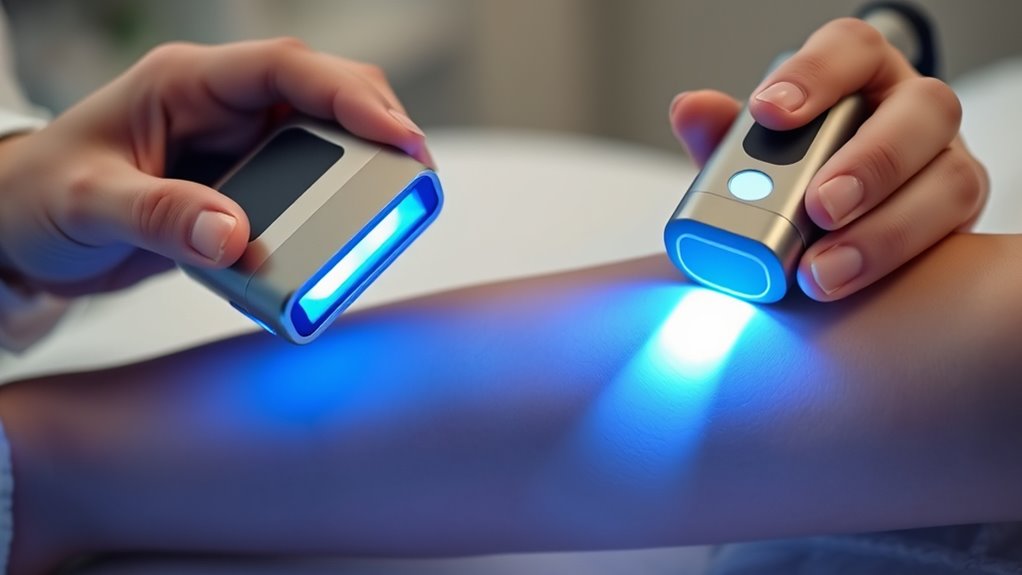
Treatment procedures for IPL and broadband light typically involve a series of sessions, with each session lasting between 20 to 30 minutes depending on the area being treated. The number of sessions varies based on skin concerns and desired results. When considering cost comparison, keep in mind that prices can differ depending on the provider’s qualifications; highly qualified practitioners may charge more but often guarantee safer, more effective treatments.
To understand the process better, consider:
- The technician’s expertise influences both safety and outcomes.
- Sessions are spaced weeks apart, allowing skin recovery.
- Multiple treatments are usually necessary for ideal results.
Being aware of these factors helps you plan your treatment timeline and budget effectively.
Effectiveness and Expected Results
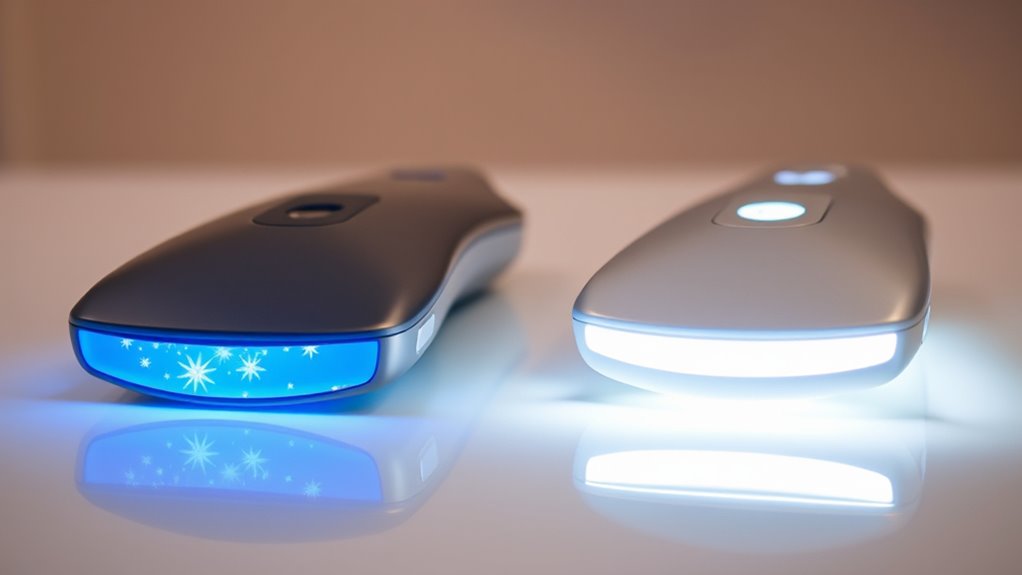
When choosing between IPL and broadband light therapies, understanding their effectiveness and expected results is crucial. Both cosmetic procedures aim to improve skin appearance, but they differ in outcomes. IPL is highly effective for skin rejuvenation, reducing pigmentation, redness, and fine lines with noticeable improvements after multiple sessions. Broadband light treatments also promote skin renewal, often providing broader coverage for various skin concerns. While results vary based on individual skin types and conditions, most patients see gradual enhancement in skin tone and texture. Expect smoother, more radiant skin after completing your recommended sessions. Keep in mind, consistent treatments are essential to achieve ideal results. Both therapies offer promising outcomes for skin rejuvenation, but your specific goals and skin type influence which approach works best.
Safety, Side Effects, and Suitability

Are IPL and broadband light therapies safe for your skin? Generally, they are safe when performed by trained professionals, but your skin pigmentation and hair removal goals influence their suitability. To guarantee safety, consider these points:
IPL and broadband light therapies are generally safe when performed by professionals, but individual skin factors matter.
- Skin Pigmentation: People with darker skin tones may face a higher risk of pigmentation changes or burns, making professional assessment essential.
- Side Effects: Common side effects include redness, swelling, or slight discomfort, which typically subside quickly.
- Suitability: If you have active infections, skin conditions, or are pregnant, these treatments might not be appropriate.
Always consult a qualified specialist to evaluate your skin type and goals. Proper screening and expert treatment minimize risks, making IPL and broadband light safer options for hair removal and skin rejuvenation.
Choosing the Right Option for Your Skin Goals

Choosing the right light therapy depends on your specific skin goals and concerns. If you’re aiming for hair removal, pigmentation reduction, or skin rejuvenation, understanding how laser safety and skin sensitivity play a role is essential. IPL and broadband light target different skin issues, so selecting the best fit guarantees safety and effectiveness. Consider this comparison:
| Goal | Suitable Treatment | Skin Sensitivity Consideration |
|---|---|---|
| Hair removal | Broadband Light | Lower sensitivity risk |
| Pigmentation | IPL | Moderate sensitivity |
| Skin rejuvenation | IPL or Broadband Light | Higher sensitivity, caution advised |
Always consult a professional to evaluate your skin sensitivity and ensure the treatment aligns with your goals for ideal, safe results.
Frequently Asked Questions
How Do IPL and Broadband Light Treatments Compare in Cost?
When comparing IPL and broadband light treatments, you’ll find that the cost varies based on treatment area, number of sessions, and provider. Generally, IPL tends to be slightly more affordable, but the cost comparison depends on your specific needs. Payment options like packages or financing can make treatments more accessible. Be sure to ask your provider about these options to find the best plan that fits your budget.
Can IPL or Broadband Light Be Combined With Other Skin Therapies?
You’ll be amazed at how IPL or broadband light can work wonders when combined with other skin therapies for ideal skin rejuvenation. Combining these treatments, known as combination therapy, enhances results and targets multiple skin concerns simultaneously. Whether paired with chemical peels or microneedling, these light therapies can boost your skin’s glow and health. Just consult your specialist to customize your treatment plan for the best, most radiant results.
Are There Specific Skin Types That Respond Better to One Treatment?
You might find that skin tone compatibility influences how well IPL or broadband light treatments work for you. Lighter skin tones tend to respond better, making treatment more effective, while darker skin may require personalized approaches to minimize risks. To get the best results, consult your specialist for treatment personalization, ensuring your skin type and tone are considered to choose the safest, most effective option tailored to your needs.
What Is the Recommended Frequency of Treatments for Optimal Results?
For ideal results, you should schedule IPL or broadband light treatments at recommended treatment intervals, usually every 3 to 4 weeks. This allows your skin to recover and respond effectively. After completing the initial series, maintenance sessions every 6 to 12 months help maintain your results. Consistently following your provider’s advice ensures you get the best benefits from your treatments and keeps your skin looking its best.
How Do I Choose Between IPL and Broadband Light for Sensitive Skin?
You might think sensitive skin can’t handle light treatments, but studies show carefully chosen options can be suitable. When choosing between IPL and broadband light, consider your skin sensitivity—broadband light typically offers gentler, more targeted treatment, making it better for delicate skin. Consult a specialist to evaluate your skin’s condition and determine the most suitable option, ensuring effective results without irritation or discomfort.
Conclusion
Ultimately, choosing between IPL and broadband light depends on your skin goals. While IPL offers targeted, precise treatments like hair removal, broadband light provides broader, versatile options for various skin concerns. Both harness light energy, but their differences shape your results and experience. Consider your desired outcomes and sensitivities—sometimes, the most advanced technology isn’t the best fit. Your perfect treatment balances effectiveness with safety, guiding you toward clearer, healthier skin.
